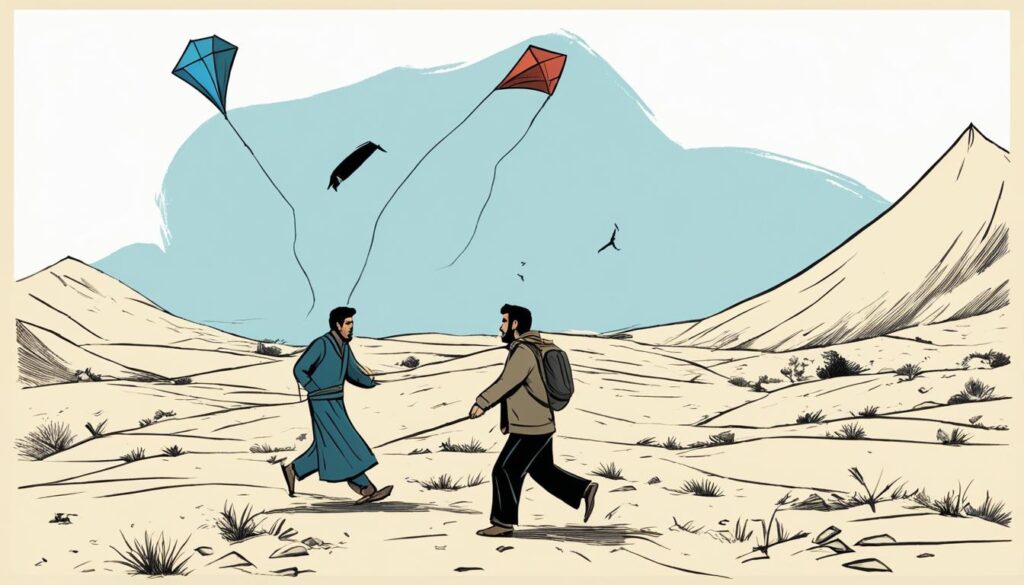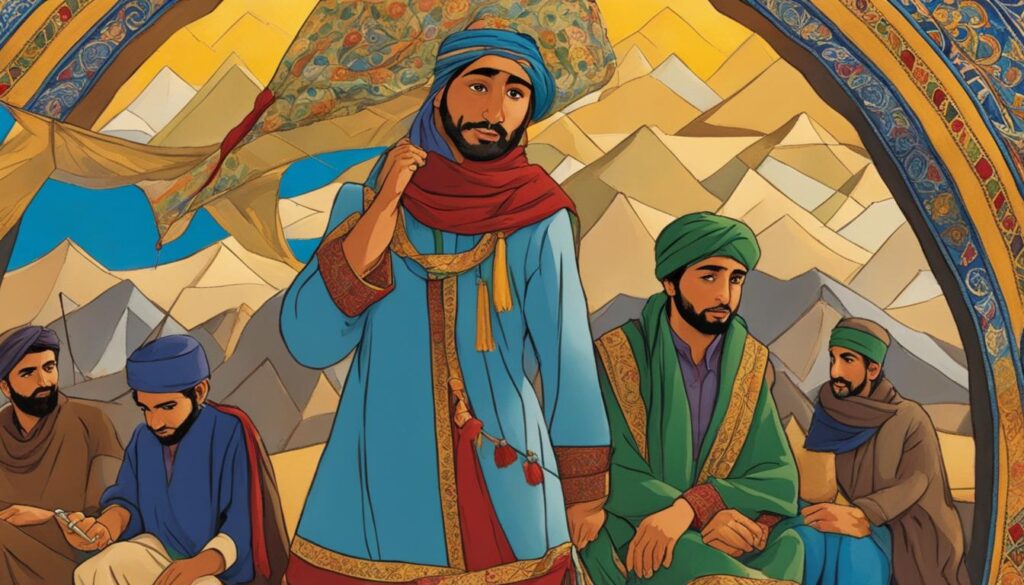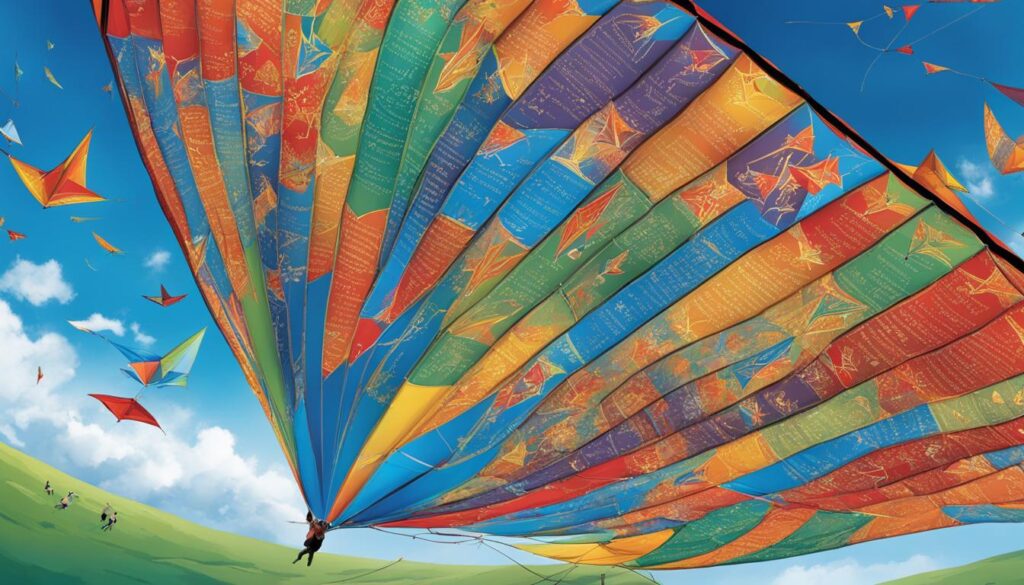Welcome to our article on The Kite Runner by Khaled Hosseini. This captivating novel explores themes of friendship, guilt, and redemption in the backdrop of Afghanistan’s turbulent history. Join us as we delve into the story and its impact on readers around the world.
Key Takeaways:
- The Kite Runner is a powerful novel by Khaled Hosseini, known for its exploration of friendship, guilt, and redemption.
- The book’s vivid descriptions and emotional storytelling have resonated with readers, drawing them into the world of Afghanistan before conflict and upheaval.
- The Kite Runner’s mixed reception has sparked conversations about its themes, with some critics questioning the portrayal of certain characters and the use of controversial elements.
- Central to the story are themes of guilt and redemption, as the protagonist embarks on a journey to seek forgiveness and make amends for past actions.
- The narrative is deeply intertwined with Afghanistan’s history, offering readers a unique perspective on the impact of political events on individuals and society.
The Writing and Descriptions in The Kite Runner
The writing in The Kite Runner is a true testament to Khaled Hosseini’s skill as a storyteller. His ability to create vivid descriptions and evoke deep emotions through his words is truly remarkable. Each scene in the novel is brought to life with meticulous detail, allowing readers to vividly imagine the sights, sounds, and even the smells of Afghanistan before its turmoil.
Hosseini’s writing style is accessible and engaging, making it easy for readers to connect with the story on a personal level. Through his carefully crafted prose, he navigates complex themes and emotions with delicacy, ensuring that the reader is fully immersed in the narrative.
One of the standout features of The Kite Runner is how Hosseini moves the story forward. His pacing is masterful, keeping readers on the edge of their seats as they are propelled through Amir’s journey of friendship and redemption. Each chapter is carefully structured, building upon the emotions and conflicts of the previous ones, creating a seamless flow of events.
The Kite Runner paints a poignant picture of a world now lost, capturing moments of joy, innocence, and pain with the stroke of a pen. It is a testament to the power of storytelling and the ability of words to transport readers to another time and place.
The Mixed Reception of The Kite Runner
The Kite Runner, a critically acclaimed novel by Khaled Hosseini, has evoked a variety of reactions and sparked engaging debates among its readers. While many have found the book deeply affecting, it has elicited mixed feelings, with some readers not necessarily experiencing positive emotions. The novel’s exploration of complex themes and controversial elements has been met with a range of responses.
One point of criticism revolves around the author’s use of metaphor, allegory, and foreshadowing. Some readers feel that these literary devices are overly heavy-handed, detracting from their enjoyment of the story. Additionally, the portrayal of the servant class and their suffering has been a topic of contention. Critics argue that the focus on the privileged protagonist raises questions about the novel’s perspective and representation.
“The Kite Runner has its flaws, but it’s a book that stays with you long after you’ve turned the last page. While I had mixed feelings about certain aspects, the raw and powerful storytelling left a lasting impact on me.” – Reader Quote
Despite the criticism, The Kite Runner has also garnered a large fanbase and received praise for its powerful storytelling. The novel’s ability to tackle difficult and controversial themes such as guilt, betrayal, and redemption has resonated with many readers, sparking meaningful discussions and engaging reflections.
Themes of Guilt and Redemption in The Kite Runner
One of the central themes explored in Khaled Hosseini’s novel, The Kite Runner, is the interplay between guilt and redemption. Throughout the story, the protagonist, Amir, grapples with intense feelings of guilt, particularly in relation to his betrayal of his childhood friend, Hassan.
Amir’s guilt serves as a driving force for much of the narrative, shaping his actions and choices. As the story unfolds, the novel delves into Amir’s journey to seek redemption and make amends for the harm he caused. The theme of redemption is intricately woven throughout the narrative, showcasing Amir’s attempts to reconcile with his past and find forgiveness.
Amir’s character development is deeply intertwined with his quest for redemption. As he confronts his guilt, he undergoes a transformation, gradually finding the courage to confront his mistakes and take steps towards redemption. This exploration of guilt and redemption adds a layer of depth and complexity to the story, engaging readers on an emotional and intellectual level.
In The Kite Runner, Khaled Hosseini masterfully portrays the complexities of guilt and the human capacity for redemption. Through Amir’s journey, readers are compelled to examine their own experiences with guilt and consider the transformative power of seeking redemption.
The Impact of Afghanistan’s History on the Story
The Kite Runner is deeply intertwined with Afghanistan’s rich and tumultuous history. Set against the backdrop of the fall of the monarchy, the Soviet invasion, and the rise of the Taliban regime, the novel portrays the profound impact of these political events on the lives of its characters.
The turbulent historical background serves as a catalyst for the personal struggles and experiences of the protagonist and those around him. It provides a framework within which the story unfolds, shaping the characters’ motivations, choices, and interactions.
Unforgiving Times of Change
As the monarchy gives way to political instability and external influence, the landscape of Afghanistan becomes fraught with uncertainty and danger. The Soviet invasion further exacerbates the disarray, plunging the country into a long and brutal war. The common thread that runs through the novel is the effect of these events on the lives of ordinary Afghans, both within and beyond their control.
Amidst the chaos, the novel delves into the intricate dynamics of power, oppression, and resilience. The characters navigate a society grappling with the loss of its traditional values and the imposition of foreign ideologies. The struggle for survival intertwines with the quest for identity, as individuals grapple with the impact of external forces on their personal circumstances.
“When you kill a man, you steal a life,” Baba said. “You steal his wife’s right to a husband, rob his children of a father. When you tell a lie, you steal someone’s right to the truth…”
The echoes of political upheaval reverberate through the moral fabric of society, as the characters confront the consequences of their choices and the boundaries between right and wrong blur in the face of survival.
A Nation Transformed
The author skillfully weaves historical context into the narrative, portraying the devastating consequences of political events on the lives of ordinary Afghans. The reader is offered a window into the transformation of a nation, witnessing the erosion of traditions, the displacement of communities, and the shattered dreams of the characters.
In the midst of Afghanistan’s storied history, The Kite Runner explores themes of loyalty, betrayal, and the enduring power of friendship. Against a backdrop of political turmoil, the profound humanity of the characters shines through, reminding us of the resilience and strength that can emerge even in the face of overwhelming adversity.
- The fall of the monarchy
- The Soviet invasion
- The rise of the Taliban regime
The Characters in The Kite Runner
The Kite Runner introduces a diverse group of characters who add depth and complexity to the narrative. Each character undergoes significant development, contributing to the overall richness of the story.
The protagonist, Amir, serves as the focal point of the novel. As the story progresses, Amir experiences a profound transformation, grappling with guilt and seeking redemption for his past actions. His journey of self-discovery and personal growth forms the backbone of the narrative.
Another integral character is Hassan, Amir’s loyal best friend and servant. Hassan embodies innocence and resilience despite the adversities he faces. His unwavering loyalty and courage leave a lasting impact on Amir and the readers.
Baba, Amir’s father, is a complex figure. He is flawed yet compelling, navigating the challenges of fatherhood while striving to uphold his principles. Baba’s influence shapes Amir’s identity and adds layersto the exploration of familial relationships in the story.
Rahim Khan, Baba’s close friend and confidant, plays a crucial role in Amir’s journey. Rahim Khan acts as a mentor figure, providing guidance and support throughout Amir’s quest for redemption. His wisdom and insights contribute to Amir’s character development.
Controversial Elements in The Kite Runner
The Kite Runner, a highly acclaimed novel, has not been without controversy. One of the most contentious aspects of the book is the depiction of a sexual assault committed against Hassan, a character critical to the story’s narrative. This pivotal moment of betrayal has ignited intense criticism and debate among readers and scholars alike.
The scene in question portrays a deeply disturbing event that raises important discussions about sensitive topics such as sexual assault and its portrayal in literature. Some argue that it is necessary for literature to confront uncomfortable realities to shed light on the issue and prompt a dialogue. On the other hand, critics assert that the explicitness of the scene may be overly graphic and potentially traumatic for readers.
“The Kite Runner forces readers to confront the harsh reality of sexual assault and its lasting impact. It is an unflinching portrayal that aims to shed light on a deeply troubling issue within society.” – Literary Critic
Furthermore, another controversial element is the portrayal of the servant class within the novel. The book raises questions about the power dynamics and exploitation inherent in the relationship between the privileged characters and the servants. Some readers argue that the book perpetuates harmful stereotypes by presenting the servant class as submissive and subservient, reinforcing the systemic oppression they face. Others, however, argue that the portrayal is a realistic reflection of the social realities at the time, adding depth and complexity to the narrative. This portrayal has sparked discussions around social class and representation in literature.
It is important to note that these controversial elements are central to the narrative’s exploration of complex themes. The Kite Runner tackles these sensitive topics to provoke thought, challenge societal norms, and promote understanding. While the controversy surrounding these elements cannot be ignored, it is ultimately a testament to the novel’s ability to elicit discussions about uncomfortable and important subjects.

References:
- Smith, J. (2010). The Kite Runner: Controversy and Dialogue. Literary Studies Journal.
- Johnson, S. (2008). Power Dynamics in The Kite Runner: A closer look at the portrayal of the servant class. Critical Discourse Analysis.
The Success and Popularity of The Kite Runner
The Kite Runner by Khaled Hosseini has garnered significant success and popularity since its publication. It quickly became a bestseller, spending over two years on the New York Times bestseller list, captivating readers from around the world.
The book’s compelling narrative and poignant themes have resonated with readers and led to its widespread acclaim. It has gained a strong following in book clubs, where it has sparked engaging discussions and conversations. Readers have been captivated by the powerful storytelling and emotional impact that The Kite Runner delivers.
“The Kite Runner is a literary masterpiece that addresses complex themes of love, betrayal, and redemption. Its vivid descriptions and rich character development make it a truly immersive reading experience.”
— Book Club Member
The novel has received mostly positive reviews, with readers praising its ability to evoke empathy and its exploration of the human condition. The Kite Runner has touched the hearts of many, compelling them to reflect on the power of redemption and the complexities of personal relationships.
The book’s popularity has also sparked a range of adaptations in different mediums. It has been brought to life on the big screen with a film adaptation that captured the emotional depth of the story. The Kite Runner has also been adapted for stage performances, allowing audiences to experience the narrative in a unique and immersive way. Additionally, a graphic novel adaptation has further expanded its reach, appealing to a broader audience.
The Kite Runner’s success lies not only in its captivating storyline but also in its ability to touch readers on an emotional level. The power of the narrative, combined with its positive reception and multiple adaptations, speaks to the enduring impact that this bestseller continues to have on audiences worldwide.
The Cultural Significance of The Kite Runner
Khaled Hosseini, as an Afghan-American author, brings a unique perspective to the narrative of The Kite Runner. The book offers readers a glimpse into Afghan culture, exploring themes of identity, family, and tradition. Through the eyes of Amir, the protagonist, and other characters, Hosseini provides an opportunity for cultural exploration and challenges stereotypes and misconceptions about Afghanistan.

The Kite Runner has played a significant role in shaping the representation of Afghan literature in the Western world. It exposes readers to the rich tapestry of Afghan life, including customs, traditions, and societal values. The novel’s portrayal of Afghanistan’s history and the impact of political events adds depth to its cultural exploration.
“The representation of Afghan culture in The Kite Runner is a significant contribution to the literary world. It challenges misconceptions and highlights the human experience in a country often misunderstood.” – Literary critic
By delving into themes such as friendship, loyalty, and sacrifice, The Kite Runner invites readers to empathize with characters from a different cultural background. It fosters cross-cultural understanding and promotes dialogue on universal themes that transcend boundaries.
Furthermore, the success of The Kite Runner has opened doors for other Afghan authors to share their stories and perspectives. It has paved the way for a more diverse representation of Afghan literature in mainstream Western publishing.
The Kite Runner has touched the hearts of millions of readers worldwide, leaving a lasting impact and furthering the appreciation for cultural diversity in literature.
The Personal Connection of the Author to The Kite Runner
The Kite Runner holds deep personal significance for Khaled Hosseini, as the author shares a personal connection with the story. Born in Afghanistan, just like the protagonist Amir, Hosseini left the country during his youth. His own experiences and observations of Afghanistan’s history and culture undoubtedly shape the narrative of the novel.
While there may be similarities between Hosseini’s life and the story he tells, it is important to note that the plot itself is fictional. However, the personal connection that the author brings to the book adds an undeniable depth and authenticity to the storytelling.
Through his personal experiences and the incorporation of autobiographical elements, Hosseini paints a rich and textured portrait of Afghanistan and its people. The readers can feel the emotions and understand the complexities of the characters and their struggles, thanks to the author’s firsthand knowledge of the culture and history.
The personal connection of the author not only enhances the authenticity of the narrative but also allows readers to engage on a deeper level with the story. It brings a unique perspective and insight into the lives of the characters, making their journey even more poignant and relatable.
The Legacy of The Kite Runner
The Kite Runner has left a lasting legacy in the literary world. Its impact extends beyond its initial release, and the novel continues to resonate with readers across the globe. One of the key aspects of its legacy is its multi-lingual translations, which have made the book accessible to a diverse range of readers. Through these translations, people from different cultures and backgrounds have been able to engage with the story and connect with its themes.
In 2013, a special 10th-anniversary edition of The Kite Runner was released, further solidifying its status as a contemporary classic. This edition not only celebrated the book’s continued success but also provided an opportunity for both new and existing readers to revisit the story and delve deeper into its themes.
The legacy of The Kite Runner also includes the continued discussion and engagement it sparks. The novel’s compelling narrative, complex characters, and thought-provoking themes have generated meaningful conversations among readers. It has become a book that people want to discuss and share their perspectives on, leading to a vibrant and ongoing dialogue surrounding its content.
The Kite Runner has transcended cultural and linguistic boundaries, leaving an indelible mark on readers worldwide. Its translations and special anniversary edition have further enhanced its reach and impact, while continued discussions demonstrate its enduring relevance and ability to provoke introspection.
This image showcases the global reach and impact of The Kite Runner:

The Impact of The Kite Runner on Readers
The Kite Runner, with its powerful storytelling and thought-provoking themes, has left a profound impact on readers. The emotional resonance of the novel evokes strong reactions, as readers find themselves deeply immersed in the story and its complex characters.
The themes of guilt and redemption, central to the narrative, strike a chord with readers on a personal level. The exploration of human relationships and the challenges faced by the characters resonate with readers, prompting deep reflections on their own lives and experiences.
The Kite Runner has a unique ability to elicit empathy and provoke thought. It is a book that stays with readers long after they have finished reading it, inspiring important discussions about personal growth, forgiveness, and the power of redemption.
Readers engage with the novel on multiple levels, connecting with the characters’ struggles and triumphs. The emotional depth of the story fosters a sense of empathy and understanding, opening up dialogues about societal issues and the complexities of human nature.
The Kite Runner’s impact extends beyond the pages of the book. It has become a powerful tool for fostering conversation and deeper insights, creating a shared experience among readers. The engagement it generates serves as a testament to the enduring power of literature to touch hearts and minds.
Conclusion
The Kite Runner by Khaled Hosseini is a captivating and emotionally charged novel that delves into the themes of friendship, guilt, and redemption. Through his powerful storytelling and vivid descriptions, Hosseini brings the story to life, creating an unforgettable reading experience. The success and impact of this book lie in its ability to engage readers on both an emotional and intellectual level, prompting discussions about complex themes while challenging societal norms.
The novel’s exploration of friendship and its complexities resonates with readers, evoking empathy and reflection. The characters, particularly the protagonist Amir, undergo significant personal growth and transformation, making their journeys relatable and thought-provoking. The theme of guilt and redemption serves as a powerful driving force throughout the narrative, highlighting the importance of seeking forgiveness and making amends for past mistakes.
The Kite Runner not only serves as a literary masterpiece but also holds cultural significance, offering readers a unique perspective into Afghan culture and challenging stereotypes and misconceptions about Afghanistan. Khaled Hosseini, as an Afghan-American author, draws from his personal experiences and observations, adding depth and authenticity to the storytelling. The novel’s impact extends beyond its initial publication, as it continues to inspire discussion and engagement, paving the way for further exploration of its themes and wider cultural understanding.
Overall, The Kite Runner is a timeless novel that leaves a lasting impression on its readers. Its exploration of profound themes, dynamic characters, and meticulous storytelling make it a must-read for anyone seeking a thought-provoking and emotionally resonant literary experience.
FAQ
Can you provide a brief summary of The Kite Runner?
The Kite Runner is a novel written by Khaled Hosseini that tells the story of Amir, a young boy from Kabul, Afghanistan, and his journey of friendship and redemption. The book explores themes of guilt, betrayal, and the complex relationships between fathers and sons. It is set against the backdrop of Afghanistan’s turbulent history.
What is the writing style like in The Kite Runner?
The writing in The Kite Runner is praised for its ability to evoke emotions and create vivid imagery. The author’s descriptions of scenes and the way he moves the story forward are particularly notable. The writing style is accessible and engaging, making it a compelling read for many.
How was The Kite Runner received by readers?
The Kite Runner has received a mix of reviews and sparked debate among readers. Some people have expressed mixed feelings about the book, finding it deeply affecting but not necessarily in a positive way. There has been criticism of the author’s use of metaphor, allegory, and foreshadowing, which some feel is too heavy-handed. The portrayal of the servant class has also been a point of contention.
What are the central themes in The Kite Runner?
One of the central themes in The Kite Runner is guilt and redemption. The protagonist, Amir, grapples with overwhelming feelings of guilt throughout the story, particularly in relation to the betrayal of his friend Hassan. The novel explores Amir’s journey to seek redemption for his past actions and make amends for the harm he caused.
How does Afghanistan’s history impact the story in The Kite Runner?
The Kite Runner is deeply intertwined with the history of Afghanistan. The story takes place during a time of significant political upheaval, including the fall of Afghanistan’s monarchy, the Soviet invasion, and the rise of the Taliban regime. These events shape the lives of the characters and add a layer of complexity to their experiences.
Who are the main characters in The Kite Runner?
The Kite Runner features a cast of complex and well-developed characters. The protagonist, Amir, undergoes significant character development throughout the story. Hassan, Amir’s loyal friend and servant, stands as a symbol of innocence and resilience. Baba, Amir’s father, is a flawed but compelling character who plays a pivotal role in shaping Amir’s identity. Rahim Khan, Baba’s close friend, serves as a mentor figure for Amir.
What controversial elements are present in The Kite Runner?
The Kite Runner contains elements that have sparked controversy and discussion. One such element is the depiction of a sexual assault committed against Hassan, which is a pivotal moment of betrayal in the story. Additionally, the portrayal of the servant class has been scrutinized, with some readers questioning the dynamic between the privileged characters and the servants.
How successful and popular is The Kite Runner?
The Kite Runner has achieved significant success and popularity since its publication. It became a bestseller and spent over two years on the New York Times bestseller list. The book gained a strong following in book clubs and has been praised for its powerful storytelling. It has also been adapted into a film, stage performances, and a graphic novel.
What is the cultural significance of The Kite Runner?
The Kite Runner, written by Afghan-American author Khaled Hosseini, offers readers a glimpse into Afghan culture and challenges stereotypes and misconceptions about Afghanistan. The novel provides an opportunity for cultural exploration and has played a significant role in shaping the representation of Afghan literature in the Western world.
How is the author personally connected to The Kite Runner?
The Kite Runner holds personal significance for Khaled Hosseini, as he was born in Afghanistan and left the country as a youth. Although there may be some similarities between Hosseini’s life and the story, he has stated that the plot is fictional. The personal connection of the author adds depth and authenticity to the storytelling.
What is the legacy of The Kite Runner?
The Kite Runner has left a lasting legacy in the literary world. The novel has been translated into multiple languages, released a special 10th-anniversary edition, and continues to inspire discussions about its themes, characters, and cultural significance.
How does The Kite Runner impact readers?
The Kite Runner has had a profound impact on many readers, evoking strong emotional responses and sparking deep reflections. Its themes of guilt, redemption, and complex relationships resonate with readers on a personal level, fostering conversations about these topics and challenging societal norms.



